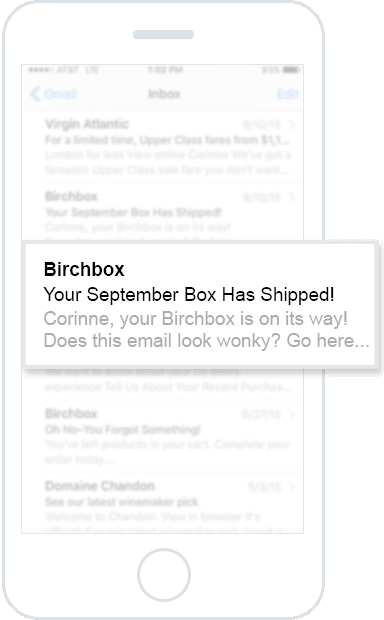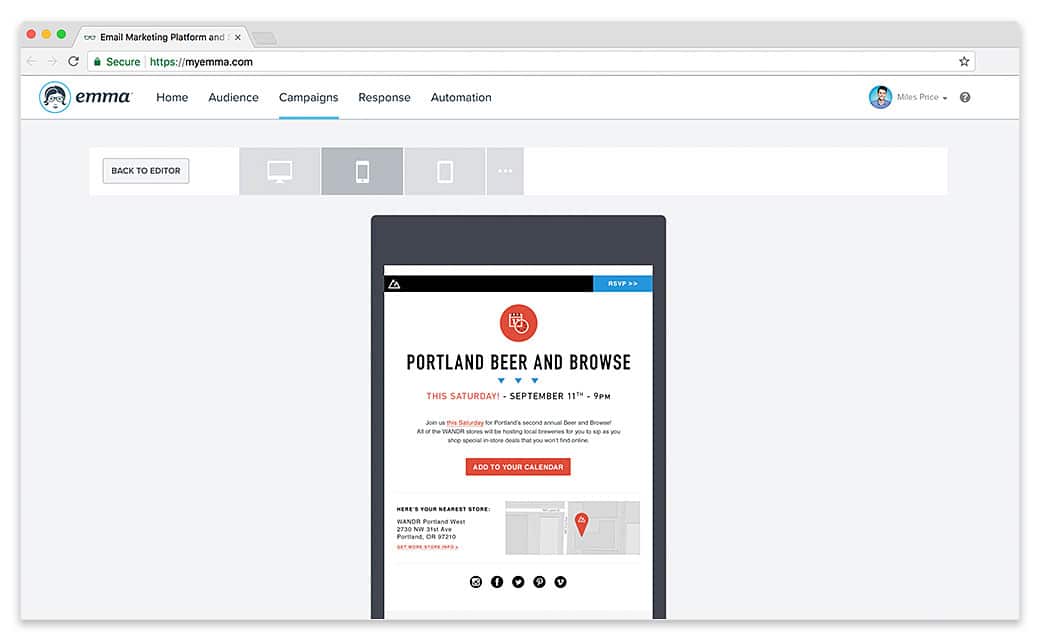What to look for in your email campaign preview
An email campaign isn’t complete unless a marketing team has taken the time to test it thoroughly first. Doing an email campaign preview can help simplify this process, and if you’ve got the right email marketing tools.
When you’ve put the resources, time and effort into creating that perfect email campaign, you want to ensure that all your effort was put to good use. By performing an email campaign preview, you’ll be able to determine several different factors, such as when to send your campaign, and you’ll also be able to check for design and formatting errors.
Elements to test for during your email campaign preview
Performing an email campaign preview is a crucial step in the process because it allows marketing teams to check for everything that may look off, while also testing to see what works and what doesn’t as far as timing and frequency of your emails.
We’ve identified six elements that all marketers should check for during their email campaign preview and summarized them below.
1. Subject lines
We’ve said it before, and we’ll say it again for you—an email’s subject line is one of the most vital pieces of an email.
An email’s subject line is what draws the subscriber in and will get them to open your email. Thirty-five percent of email subscribers open an email based on the subject line.
Remember, you want a subject link that is between 5-10 words at most, but it needs to be interesting enough to entice a reader to click on it.
Depending on the marketing tools being used, a subject line can be tested for a variety of things:
-
Topic – Is it interesting?
-
Length – Does it fit into the recommended word length?
-
Offer/Promo – What sort of offer entices your subscribers more?
-
Personalization – Does adding a subscriber’s first name perform better than their first and last?
Image Source: Topshop
2. Pre-header text
While an email’s subject line may be the most vital part of the initial process, the pre-header text is a close second.
The pre-header is the material that appears below the subject line. In the example below, the pre-header is the grey text beneath the “Birchbox: Your September Box Has Shipped” subject line.

Image Source: Campaign Monitor
In today’s digital world, not many brands keep the pre-header empty.
It’s prime real estate when it comes to an email. After the subject line, the pre-header can include information that some subscribers consider essential when considering to open the email or ignore it.
Another element that can be tested here is the content that you decide to include. Doing an A/B test allows you to try out different content within the pre-header and compare the two to see which one receives a better open rate.
Something to keep in mind when testing your pre-header content and your subject line is that 98% of Gen Zs worldwide owns a smartphone. This means that you should assume subscribers are going to be viewing their email on a smartphone, so optimizing this information is crucial to avoid being swiped off to the trash bin.
3. Timing
Timing and frequency of emails can play a big role in increasing both your open and click-through rates.
Unfortunately, there’s no universal answer as to when an email should be sent out, or how frequently a brand should be sending them. What it comes down to is the brand and the overall demographics of subscribers.
During your email campaign preview process, try switching up your average time and day of when you send out material such as your brand’s newsletter. Instead of sending it out weekly, try sending it out bi-weekly. Instead of sending it out at 10 a.m., try sending it out at 5 p.m. Then compare the numbers and see which provides you with the best open and click-through rate. Remember, this isn’t something that can be perfected, so try testing out different types of emails and sending them out at different frequencies and different times to see which performs better.
4. Content
Testing your email content can help guide you as to not only what your subscribers want to see from you, but also provide a better insight into who your audience is.
-
Do they prefer informational content?
-
Do promotional codes or offers perform better?
-
Do they appreciate suggested content or products within their emails?
-
Do they respond better to a specific email length?
By performing an email campaign preview, you’ll begin to understand better who your audience is and what they expect from you.
5. Call to action
Testing your call to action (CTA) means not only testing the CTA copy but how you physically present it to them. The CTA is what will drive subscribers to your website, and in return, it should help drive them through your marketing funnel and convert them from subscriber to consumer.
Tracking your overall click-through and conversion rates is one way to test what works and what doesn’t. However, performing an A/B comparison test could be just as beneficial. This involves sending a test version A and B to two small groups of subscribers and seeing how they perform.
6. Overall design/layout
Remember how we mentioned that 98% of Gen Zs worldwide owns a smartphone? Well, they aren’t the only ones. As a whole, 54% of email recipients now choose to open their email on their mobile devices. This means that performing an email campaign preview is vital not only for the elements listed above but for checking how the overall design and layout of the email as well.
When it comes to your email’s design, you want something that will be simple to read, scan, and something that is easy on the eyes. While previewing your email campaigns, you’ll want to consider:
-
Avoiding the use of too many columns
-
The use of text size that is too small (or too big)
-
The size, shape, and image used for your CTA
Image Source: Emma
Popular ways to test your email campaign
Once you have defined and outlined your core components of the new email campaign, it’s time to start testing.
Depending on the marketing tools you use, there may be a variety of different settings and parameters you can test for. However, for those who have limited options, two email campaign previews are relatively simple to perform.
A/B test types
Simply put, A/B testing is an experiment that allows two or more variants of a page or campaign to be tested at random. This is done by sending a random test sample to two different test groups. After a given period, a statistical analysis is used to help determine which sample performed better.
In the case of an email campaign, a marketing team can test one variation of the elements listed above against a second variation. Sample group A would receive one variation and sample group B would receive the other. After the predetermined period of time, the results are then analyzed, and the marketing team can pick and edit the winning campaign.
Design and spam testing
Another tool is the design and spam test. While some marketing tools offer this service to customers, it is possible to run your own tests if your resources are limited.
When it comes to testing the overall design of your email campaign, you can always test the design by sending test emails to yourself or someone else on the marketing team. This will at least allow you an option to preview the email on different platforms, such as mobile devices and on computers.
Spam filters are another great tool because they help you avoid sending materials that may result in being labeled spam by email service providers, which can result in severe repercussions for your brand.
Wrap up
Performing an email campaign preview is only one step of the email marketing process for brands. However, it is a vital one.
Essential elements to preview include:
-
Subject line/pre-header
-
Content
-
Design/layout
-
Frequency/yiming
Want help viewing your email campaigns before you sent them out? Let Emma get you started with our email inbox previews.
MOST RECENT ARTICLES
Want to engage your audience and grow your brand? Try Emma's robust easy-to-use product today.















